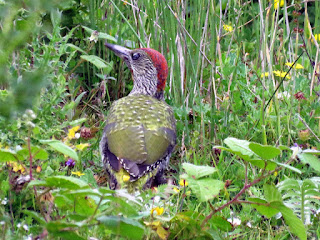Today I made another visit to the Shropshire Ornithological Society reserve at Venus Pool. Highlights included below were five different Green Sandpipers and a cooperative juvenile Green Woodpecker, both of which tempted the camera ....
As no Mute Swans breed here the non-breeders are safe and there was a small gathering. Here they go for a fly-about.
The upper-wing shows some brown so these are first-year birds ....
... not evident from below. The dull colour of the bill tells us they are immature, but does not really age them.
A rather unexpected sighting in mid-July was this breeding plumage Wigeon. Most birds are breeding far to the N and E of the UK. Apparently in moult as the white forewing patch does not usually show so clearly except in flight.
A reflective Little Egret showing its yellow feet.
Seems to be happy about something (there is an annoying out of focus blade of grass in the foreground!)
‘Got one!’
Another successful fishing expedition. It will need quite a few of these for a decent meal.
If you think gulls are white think again! An adult Black-headed Gull compared with a Little Egret.
And here is one in flight.
‘Shall we dance?’. The Paso Doble I think. The Lapwings look as if they might join in! In fact the two Little Egrets were have a small territorial dispute and it was not at all friendly.
A stately reflecting Grey Heron.
Two for the price of one – a Little Egret closes on the Grey Heron.
And here side-by-side. There did not seem to be any animosity between these even though they would be after the same prey.
This juvenile Grey Heron looks pleased with its catch.
It seemed to have no problem catching small fish either.
Time for a good shake to realign those feathers.
This Green Sandpiper is taking it easy. Why ‘green’. When adult bird are in fresh plumage on the breeding grounds there is a green gloss to the feathers – in the same way that Lapwings show green, only much less obvious. Note the supercilium in front of the eye only.
Two birds here. The bird in the foreground must be a juvenile to be this ‘spotty’ – on this species the spots are typically very small and not noticeable. When I first saw them I did a double-take as the spots suggested the smaller and less frequently encountered Wood Sandpiper.
Two more (there were five present)
And a trio here with the middle bird perhaps moulting out of spotty juvenile plumage.
This preening bird is exposing dark bars on the tail and the very white rump – usually all you notice as the bird flushes off calling is the white. The call is very distinctive.
We can get an appreciation of the size of a Green Sandpiper when we see it alongside a lumbering Wood Pigeon.
And again – what is the attraction between these species?
Here we realise how bulky a Lapwing is.
Talking of Wood Pigeons ... is this one about to land on water?
Flaps, air brakes, reverse thrust all in operation here.
Made it to dry land!
What is this lurking in the grass – a Green Woodpecker
A chin-up view. This is a stripy and spotty juvenile. Note the small red mark behind the bill. This suggests that it is a male – on an adult male this has a black border. The female lacks the red inside the same black area.
Note the pale blue eye.
Here no doubt tucking in to its favourite food – ant eggs. It has a very long tongue to reach deep in to ant nests and the tongue has barbs to hook out the eggs. (the yellow at the bird’s thigh is an out-of-focus buttercup in the foreground).
A massive bill for getting in to soft ground.
A species I don’t see well all that often – Yellow Wagtails nest in crops and can occasionally be seen on surrounding wires. Otherwise normally as fly-overs. This one popped in for a wash and brush up. Compare the colour with what is probably Meadow Vetchling (
Lathyrus pratensis).
(Ed Wilson)

































